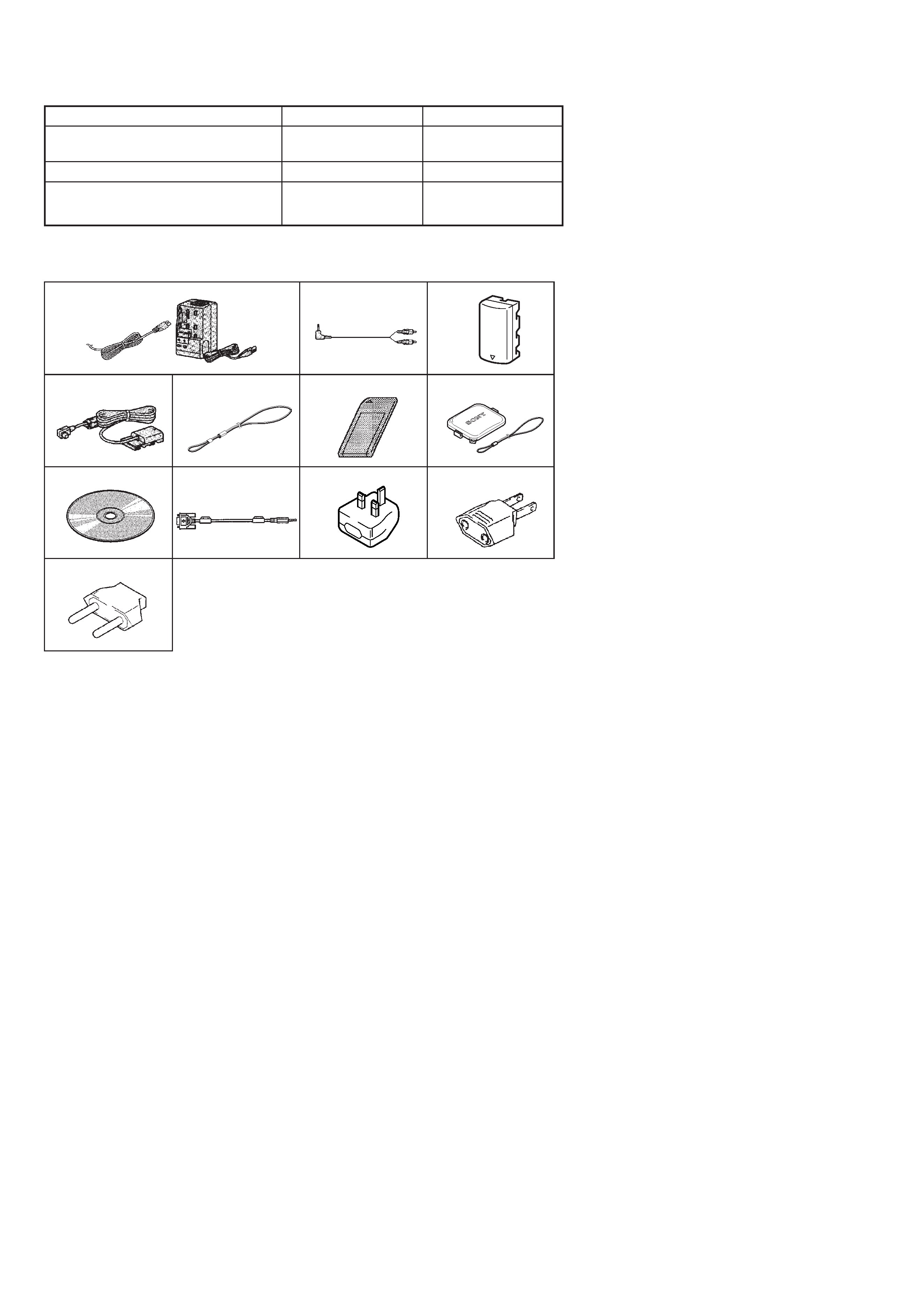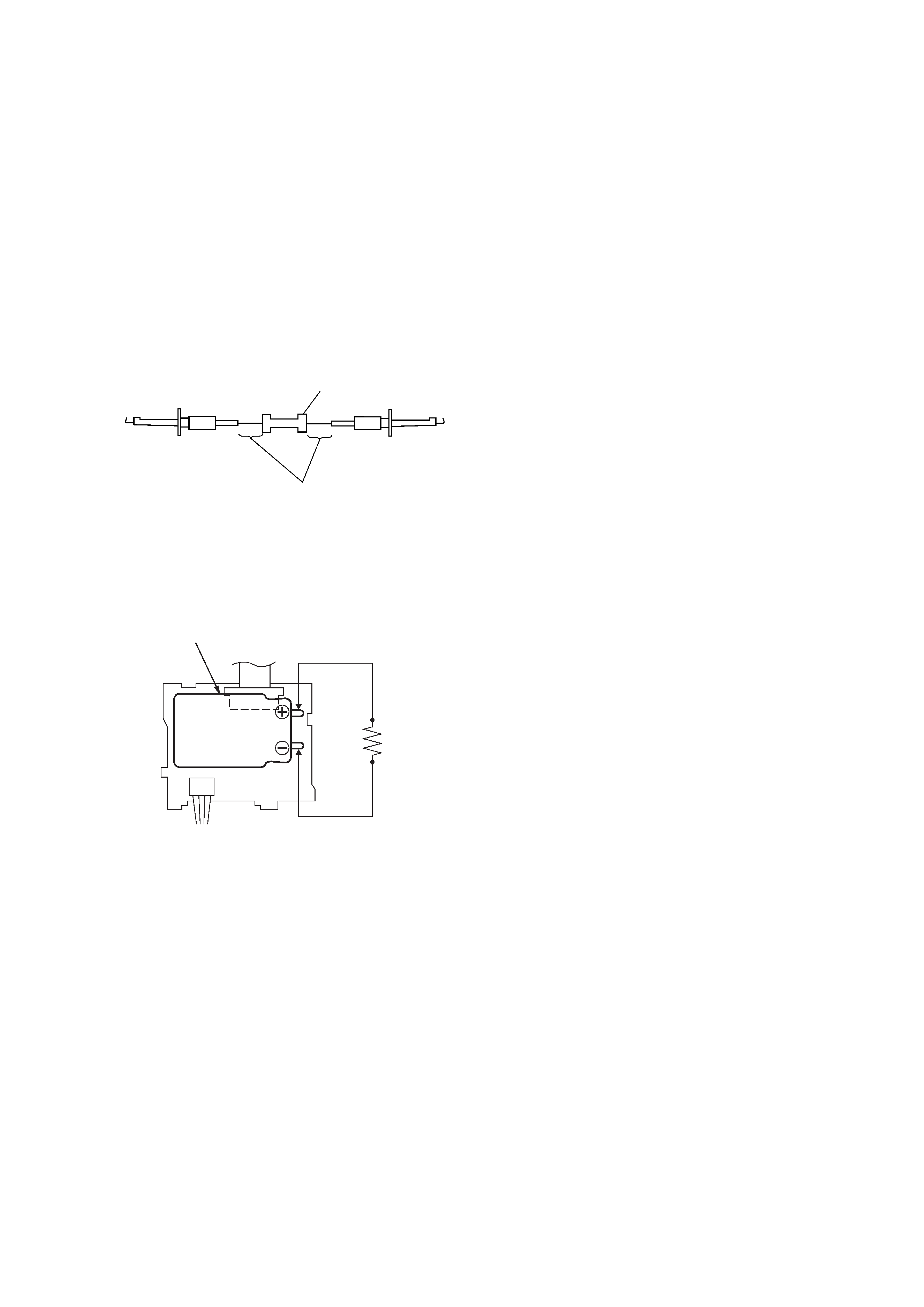
DSC-F55/F55E
US Model
Canadian Model
Tourist Model
DSC-F55
E Model
DSC-F55/F55E
AEP Model
UK Model
Australian Model
Hong Kong Model
Chinese Model
DSC-F55E
SERVICE MANUAL
DIGITAL STILL CAMERA
MICROFILM
SPECIFICATIONS
Photo : DSC-F55E
Ver 1.2
2000.10
With SUPPLEMENT-1 (9-974-166-81)
With SUPPLEMENT-2 (9-974-166-82)

-- 2 --
SAFETY-RELATED COMPONENT WARNING!!
COMPONENTS IDENTIFIED BY MARK
! OR DOTTED LINE WITH
MARK
! ON THE SCHEMATIC DIAGRAMS AND IN THE PARTS
LIST ARE CRITICAL TO SAFE OPERATION. REPLACE THESE
COMPONENTS WITH SONY PARTS WHOSE PART NUMBERS
APPEAR AS SHOWN IN THIS MANUAL OR IN SUPPLEMENTS
PUBLISHED BY SONY.
ATTENTION AU COMPOSANT AYANT RAPPORT
À LA SÉCURITÉ!
LES COMPOSANTS IDENTIFÉS PAR UNE MARQUE
! SUR LES
DIAGRAMMES SCHÉMATIQUES ET LA LISTE DES PIÈCES SONT
CRITIQUES POUR LA SÉCURITÉ DE FONCTIONNEMENT. NE
REMPLACER CES COMPOSANTS QUE PAR DES PIÈSES SONY
DONT LES NUMÉROS SONT DONNÉS DANS CE MANUEL OU
DANS LES SUPPÉMENTS PUBLIÉS PAR SONY.
1.
Check the area of your repair for unsoldered or poorly-soldered
connections. Check the entire board surface for solder splashes
and bridges.
2.
Check the interboard wiring to ensure that no wires are
"pinched" or contact high-wattage resistors.
3.
Look for unauthorized replacement parts, particularly
transistors, that were installed during a previous repair. Point
them out to the customer and recommend their replacement.
4.
Look for parts which, through functioning, show obvious signs
of deterioration. Point them out to the customer and
recommend their replacement.
5.
Check the B+ voltage to see it is at the values specified.
6.
Flexible Circuit Board Repairing
· Keep the temperature of the soldering iron around 270°C
during repairing.
· Do not touch the soldering iron on the same conductor of the
circuit board (within 3 times).
· Be careful not to apply force on the conductor when soldering
or unsoldering.
SAFETY CHECK-OUT
After correcting the original service problem, perform the following
safety checks before releasing the set to the customer.
Model
Destination
Video signal
Shutter speed
DSC-F55
US, Canadian, Tourist, E
NTSC
Automatic
(1/30 1/10000)
DSC-F55E
AEP, UK, Australian,
Hong Kong, Chinese, E
PAL
Automatic
(1/25 1/10000)
Table for differences of function
Supplied accessories
1 AC-VF10 AC power adaptor/charger,
Power cord (1)
2 A/V connecting cable (1)
3 NP-F10 Battery pack (1)
4 DK-115 connecting cord (1)
5 Hand strap (1)
6 Memory Stick (4MB) (1)
7 Lens cap/Lens cap strap (1)
8 Sony Picture Gear 3.2Lite (1)
(Compact Disk)
9 PC serial cable (1)
!º Conversion plug 3P adaptor (1)
UK, Hong Kong model
!¡ 2-pin conversion adaptor (1)
E model
!TM 2-pin conversion adaptor (1)
Tourist model
12
3
4567
89!º!¡
!TM

-- 3 --
TABLE OF CONTENTS
SERVICE NOTE ····································································· 5
1.
GENERAL
Parts identification ····································································· 1-1
Preparation ················································································· 1-1
1 Charging the battery pack ··················································· 1-1
2 Installing the battery pack ··················································· 1-2
3 Inserting a Memory Stick ··················································· 1-2
4 Setting the date and time ····················································· 1-2
Recording ·················································································· 1-3
1 Recording still images ························································ 1-3
2 Recording moving images ·················································· 1-3
Playing back ·············································································· 1-3
1 Playing back still images ···················································· 1-3
2 Playing back moving images ·············································· 1-4
3 Viewing images using a personal computer ························ 1-4
Various ways of recording ························································· 1-5
Changing the lens orientation Face to face recording ········· 1-5
Using the self-timer ······························································· 1-5
Selecting brightness of the flash (FLASH LEVEL) ·············· 1-5
Recording images in macro ··················································· 1-5
Recording enlarged images Zoom recording ······················ 1-6
Enjoying Picture Effect ·························································· 1-6
Selecting image quality (QUALITY) ···································· 1-6
Selecting image size ······························································ 1-6
Selecting recording mode (REC MODE) ······························ 1-6
Adjusting exposure (EXPOSURE) ········································ 1-7
Adjusting the white balance ··················································· 1-7
Various ways of playback ·························································· 1-7
Playing back multiple images at a time (INDEX) ················· 1-7
Enlarging a part of the image Zoom and trimming ············ 1-8
Rotating image (ROTATE) ···················································· 1-8
Playing back images in a continuous loop (SLIDE SHOW) ·· 1-8
Preventing accidental erasure (PROTECT) ··························· 1-8
Deleting images (DELETE) ·················································· 1-9
Formatting (initializing) a Memory Stick ······························ 1-9
Changing the menu setting ························································ 1-9
Changing the menu setting ···················································· 1-9
Setting the mode of each item ············································· 1-10
Using image data with other equipment ·································· 1-10
Using the house current (mains) ·········································· 1-10
Watching images on a TV screen ········································ 1-10
Printing the recorded images ··············································· 1-11
Marking a print mark on an image ······································ 1-11
Additional information ···························································· 1-11
Precautions ··········································································· 1-11
Troubleshooting ··································································· 1-12
Self-diagnosis display ·························································· 1-12
Warning and notice messages ·············································· 1-12
2.
DISASSEMBLY
2-1.
Cabinet (front) Assembly and Check Cover ···················· 2-1
2-2.
DD-126 Board ································································· 2-2
2-3.
Lens Cabinet Assembly ··················································· 2-2
2-4.
Lens Assembly, Microphone, Flash Unit ························ 2-3
2-5.
MM-39, SY-54 Boards ···················································· 2-4
2-6.
Control Switch Block (MS)/(HF) ···································· 2-4
2-7.
LCD Panel Block ····························································· 2-5
2-8.
Circuit Boards Location ·················································· 2-6
2-9.
Flexible Boards Location ················································ 2-6
3.
BLOCK DIAGRAMS
3-1.
Overall Block Diagram ··················································· 3-1
3-2.
Camera/Memory Stick Block Diagram (1) ····················· 3-4
3-3.
Camera/Memory Stick Block Diagram (2) ····················· 3-7
3-4.
Mode Control Block Diagram ······································· 3-11
3-5.
LCD Block Diagram ····················································· 3-13
3-6.
Power Block Diagram ··················································· 3-16
4.
PRINTED WIRING BOARDS AND
SCHEMATIC DIAGRAMS
4-1.
Frame Schematic Diagram ·············································· 4-1
4-2.
Printed Wiring Boards and Schematic Diagrams ············ 4-4
· CD-224 (CCD Imager)
Printed Wiring Board and
Schematic Diagram ········································· 4-5
· SY-54 (Camera)(1/10)
Schematic Diagram ········································· 4-7
· SY-54 (Camera DSP)(2/10)
Schematic Diagram ······································· 4-10
· SY-54 (LCD Drive)(3/10)
Schematic Diagram ······································· 4-13
· SY-54 (Timing Generator)(4/10)
Schematic Diagram ······································· 4-16
· SY-54 (VIDEO)(5/10)
Schematic Diagram ······································· 4-19
· SY-54 (SH DSP)(6/10)
Schematic Diagram ······································· 4-22
· SY-54 (Serial I/O)(7/10)
Schematic Diagram ······································· 4-25
· SY-54 (Audio)(8/10)
Schematic Diagram ······································· 4-27
· SY-54 (Lens Motor Drive)(9/10)
Schematic Diagram ······································· 4-29
· Control Switch Block (MS/HF)
Schematic Diagram ······································· 4-31
· SY-54 (HI Control)(10/10)
Schematic Diagram ······································· 4-34
· SY-54 (Camera, Camera DSP, LCD Drive, Timing
Generator, Video, SH DSP, Serial I/O, Audio,
Lens Motor Drive, HI Control)
Printed Wiring Board ···································· 4-37
· VL-27 (Back Up Battery)
Printed Wiring Board and
Schematic Diagram ······································· 4-42
· MM-39 (Memory)
Printed Wiring Board ···································· 4-43
· MM-39 (Memory)
Schematic Diagram ······································· 4-45
· DD-126 (DC-DC Converter)
Printed Wiring Board ···································· 4-49
· DD-126 (DC-DC Converter)
Schematic Diagram ······································· 4-51
5.
ADJUSTMENTS
1.
Before starting adjustment ··············································· 5-1
1-1.
Adjusting items when replacing main parts and boards ···· 5-2
5-1.
ADJUSTMENTS ····························································· 5-3
1-1.
Preparations before Adjustment ······································ 5-3
1-1-1. List of Service Tools ························································ 5-3
1-1-2. Preparations ····································································· 5-4
1-1-3. Discharging of the strobe power supply ·························· 5-4
1-1-4. Precaution ········································································ 5-6
1.
Setting the Switch ···························································· 5-6
2.
Order of Adjustments ······················································ 5-6
3.
Subjects ··········································································· 5-6
1-2.
Initialization of B, D, E, F Page Data ······························ 5-7
1-2-1. Initialization of D Page Data ··········································· 5-7
1.
Initializing the D Page Data ············································ 5-7
2.
Modification of D Page Data ··········································· 5-7
3.
D Page Table ···································································· 5-7
1-2-2. Initializing the B, E, F Page Data ·································· 5-10
1.
Initializing the B, E, F Page Data ·································· 5-10
2.
Modification of B, E, F Page Data ································ 5-10
3.
F Page Table ·································································· 5-10
4.
E Page Table ·································································· 5-13
5.
B Page Table ·································································· 5-15

-- 4 --
1-3.
Video System Adjustments ············································ 5-18
1.
Video Sync Level Adjustment (SY-54 board) ··············· 5-18
2.
Video Burst Level Adjustment (SY-54 board) ··············· 5-18
3.
Video Y Level Check (SY-54 board) ····························· 5-18
1-4.
Camera System Adjustments ········································· 5-19
1.
HALL Adjustment ························································· 5-19
2.
Flange Back Adjustment (Using Minipattern Box) ······· 5-20
3.
Flange Back Adjustment
(Using Flange Back Adjustment Chart) ························ 5-21
4.
Flange Back Check ························································ 5-21
5.
Picture Frame Setting ···················································· 5-22
6.
F No. Standard Data Input ············································· 5-22
7.
Mechanical Shutter Adjustment ···································· 5-22
8.
Light Level Adjustment ················································· 5-23
9.
Auto White Balance Standard Data Input ····················· 5-23
10.
Auto White Balance Adjustment ··································· 5-24
11.
Color Reproduction Adjustment ···································· 5-25
11-1. Color Reproduction Adjustment ···································· 5-25
11-2. Color Reproduction Check ············································ 5-25
11-3. Processing after Completing Adjustments ···················· 5-25
12.
White Balance Check ···················································· 5-26
13.
Strobe White Balance Adjustment ································· 5-26
14.
Strobe Light Level and White Balance Check ·············· 5-27
15.
CCD Defect Compensation ··········································· 5-27
16.
CCD Defect Compensation Check ································ 5-28
1-5.
LCD System Adjustment ··············································· 5-29
1.
LCD Initial Data Input ·················································· 5-29
2.
VCO Adjustment (SY-54 board) ··································· 5-30
3.
D Range Adjustment (SY-54 board) ······························ 5-30
4.
Bright Adjustment (SY-54 board) ·································· 5-31
5.
Contrast Adjustment (SY-54 board) ······························ 5-31
6.
Color Adjustment (SY-54 board) ··································· 5-32
7.
V-COM Level Adjustment (SY-54 board) ····················· 5-32
8.
V-COM Adjustment (SY-54 board) ······························· 5-33
9.
White Balance Adjustment (SY-54 board) ···················· 5-33
1-6.
System Control System Adjustment ······························ 5-34
1.
Battery End Adjustment (SY-54 board) ························· 5-34
5-2.
SERVICE MODE ·························································· 5-35
2-1.
Adjustment Remote Commander ·································· 5-35
1.
Using the Adjustment Remote Commander ·················· 5-35
2.
Precautions Upon Using the Adjustment Remote
Commander ··································································· 5-35
2-2.
Data Process ·································································· 5-36
2-3.
Service Mode ································································· 5-37
1.
Setting the Test Mode ···················································· 5-37
2.
Bit Value Discrimination ··············································· 5-37
3.
Switch Check (1) ··························································· 5-38
4.
Switch Check (2) ··························································· 5-38
5.
LED Check ···································································· 5-38
6.
REPAIR PARTS LIST
6-1.
Exploded Views ······························································· 6-1
6-1-1. Overall Section ································································ 6-1
6-1-2. Cabinet (front) Section ···················································· 6-2
6-1-3. Camera Block Section ····················································· 6-3
6-1-4. Cabinet (rear) Section ······················································ 6-4
6-2.
Electrical Parts List ························································· 6-5
* The color reproduction frame is shown on page 153.

-- 5 --
SERVICE NOTE
[Discharging of the FLASH unit's charging capacitor]
The charging capacitor of the FLASH unit is charged up to the
maximum 300 V potential.
There is a danger of electric shock by this high voltage when the
capacitor is handled by hand. The electric shock is caused by the
charged voltage which is kept without discharging when the main
power of the DSC-F55/F55E is simply turned off. Therefore, the
remaining voltage must be discharged as described below.
Preparing the Short Jig
To preparing the short jig. a small clip is attached to each end of a
resistor of 1k
/1W (1-215-869-11)
Wrap insulating tape fully around the leads of the resistor to prevent
electrical shock.
Discharging the Capacitor
Short circuits between the positive and the negative terminals of
charged capacitor with the short jig about 10 seconds.
1k
/1W
Wrap insulating tape.
FLASH UNIT
Short jig
Capacitor
